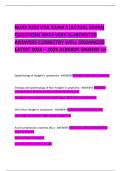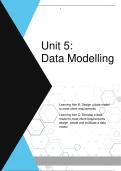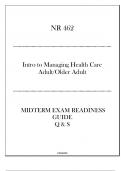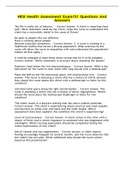NURS 5315 UTA EXAM 2 (ACTUAL EXAM)
QUESTIONS WITH VERY ELABORATED
ANSWERS CORRECTRY WELL ORGANIZED
LATEST 2024 – 2025 ALREADY GRADED A+
Epidemiology of Hodgkin's Lymphoma - ANSWERS-Possibly Epstein Barr, unknown
Etiology and Epidemiology of Non-Hodgkin's Lymphoma - ANSWERS-Malignant
transformation of lymphocytes, no Reed-Sternberg cells
Caused by immunosuppression, AIDS, Hep C, EBV, post transplantation
CM of Non-Hodgkin's Lymphoma - ANSWERS-Generalized lymphadenopathy
Late stages bring fever, night sweats, weight loss
Acute Lymphocytic Leukemia (ALL) - ANSWERS-Marked by >30% lymphoblasts in
blood or marrow
Most common in children
Survival rate decreases with age
,CM: fever, pallor, bleeding, fatigue, lymphadenopathy, infection, joint pain,
splenomegaly, hepatomegaly, night sweats, weight loss, anemia,
thrombocytopenia, petechiae, ecchymosis
Cytokines - ANSWERS-Soluble factors that contribute to the regulation of innate
or adaptive resistance by affecting other neighboring cells. Can be pro-
inflammatory or anti-inflammatory. Can react quickly or be more delayed.
Leukotrines - ANSWERS-Released when mast cells degranulate, prolong the
inflammatory process. Cause vasodilation, attract neutrophils, monocytes, and
eosinophils.target of inhibition for singular.
Prostaglandins - ANSWERS-Released when mast cells degranulate, are produced
by the arachidonic pathway. Cause vasodilation, platelet aggregation at site of
injury, pain, and fever.
Chemotactic factors - ANSWERS-Biochemical substance that attracts leukocyte to
the site of inflammation
HIV EIA (3rd generation immunoassay) - ANSWERS-can use urine, saliva, or serum
(most accurate), need to wait until 12 weeks post exposure to see antibodies,
>99% accurate
4th generation immunoassay- "gold standard"
measures P24 antigen
, can test 10 days post exposure
Mast cell - ANSWERS-Cellular bags of granules located in loose connective tisssue
close to blood vessels. Activation initiates inflammatory process.
Histamine - ANSWERS-Causes vasodilation, increases vascular permeability,
increases blood flow to the site of injury- causes erythema and swelling.
Neutrophils - ANSWERS-Predominant leukocyte at work during the early stages of
acute inflammation
Monocytes - ANSWERS-Become macrophages when entering the tissue,
responsible for presenting antigens to the CD4 cell which triggers T-cell immunity
and B-cell immunity.
Releases additional cytokines IL1, IL6, TNF.
Cytokine IL1 function - ANSWERS-Causes fever, activates phagocytes &
lymphocytes and also increases the release of IL6a
Cytokine IL6 function - ANSWERS-Stimulates production of acute phase reactants
and promotes growth and stimulation of RBCs
Cytokine TNF function - ANSWERS-Causes fever, increases synthesis of
proinflammatory proteins by liver, causes muscle wasting, induces thrombosis







